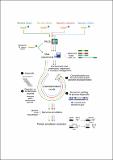Por favor, use este identificador para citar o enlazar a este item:
http://hdl.handle.net/10261/280377COMPARTIR / EXPORTAR:
 SHARE SHARE
 CORE
BASE CORE
BASE
|
|
| Visualizar otros formatos: MARC | Dublin Core | RDF | ORE | MODS | METS | DIDL | DATACITE | |

| Título: | Divergent genomic trajectories predate the origin of animals and fungi |
Autor: | Ocaña-Pallarès, Eduard CSIC ORCID; Williams, Tom A.; López-Escardó, David CSIC ORCID ; Arroyo, Alicia S.; Pathmanathan, Jananan S.; Bapteste, Eric; Tikhonenkov, Denis V.; Keeling, Patrick J.; Szöllősi, Gergely J.; Ruiz-Trillo, Iñaki CSIC ORCID | Fecha de publicación: | sep-2022 | Editor: | Nature Publishing Group | Citación: | Nature 609: 747-753 (2022) | Resumen: | Animals and fungi have radically distinct morphologies, yet both evolved within the same eukaryotic supergroup: Opisthokonta1,2. Here we reconstructed the trajectory of genetic changes that accompanied the origin of Metazoa and Fungi since the divergence of Opisthokonta with a dataset that includes four novel genomes from crucial positions in the Opisthokonta phylogeny. We show that animals arose only after the accumulation of genes functionally important for their multicellularity, a tendency that began in the pre-metazoan ancestors and later accelerated in the metazoan root. By contrast, the pre-fungal ancestors experienced net losses of most functional categories, including those gained in the path to Metazoa. On a broad-scale functional level, fungal genomes contain a higher proportion of metabolic genes and diverged less from the last common ancestor of Opisthokonta than did the gene repertoires of Metazoa. Metazoa and Fungi also show differences regarding gene gain mechanisms. Gene fusions are more prevalent in Metazoa, whereas a larger fraction of gene gains were detected as horizontal gene transfers in Fungi and protists, in agreement with the long-standing idea that transfers would be less relevant in Metazoa due to germline isolation3,4,5. Together, our results indicate that animals and fungi evolved under two contrasting trajectories of genetic change that predated the origin of both groups. The gradual establishment of two clearly differentiated genomic contexts thus set the stage for the emergence of Metazoa and Fungi | Descripción: | 22 pages, 4 figures, supplementary information https://doi.org/10.1038/s41586-022-05110-4.-- Data availability: The raw sequence data and assembled genomes generated in this study have been deposited in the European Nucleotide Archive (ENA) at EMBL-EBI under accession number PRJEB52884 (https://www.ebi.ac.uk/ena/browser/view/PRJEB52884). The genome assemblies are also available in figshare (https://doi.org/10.6084/m9.figshare.19895962.v1). Protein sequences of the species used in this study were downloaded from the GenBank public databases (https://www.ncbi.nlm.nih.gov/protein/), Uniprot (https://www.uniprot.org/), JGI genome database (https://genome.jgi.doe.gov/portal/) and Ensembl genomes (https://www.ensembl.org). The following specific databases were also used in this study: Pfam A v29 (https://pfam.xfam.org/), EggNOG emapperdb-4.5.1 (http://eggnog5.embl.de) and UniProt reference proteomes release 2016_02 (https://www.uniprot.org/). The supporting data files of this study are available in the following repository: https://doi.org/10.6084/m9.figshare.13140191.v1.-- Code availability: The most relevant custom code developed for this study (the MAPBOS pipeline and the machine learning classifiers) is available at https://doi.org/10.5281/zenodo.6586559 | Versión del editor: | https://doi.org/10.1038/s41586-022-05110-4 | URI: | http://hdl.handle.net/10261/280377 | DOI: | 10.1038/s41586-022-05110-4 | ISSN: | 0028-0836 | E-ISSN: | 1476-4687 |
| Aparece en las colecciones: | (ICM) Artículos (IBE) Artículos |
Ficheros en este ítem:
| Fichero | Descripción | Tamaño | Formato | |
|---|---|---|---|---|
| Ocaña_et_al_2022.pdf | 33,54 MB | Adobe PDF |  Visualizar/Abrir | |
| Ocaña_et_al_2022_suppl_1.pdf | 4,64 MB | Adobe PDF |  Visualizar/Abrir | |
| Ocaña_et_al_2022_suppl_2.pdf | 3,8 MB | Adobe PDF |  Visualizar/Abrir | |
| Ocaña_et_al_2022_suppl_3.pdf | 1,36 MB | Adobe PDF |  Visualizar/Abrir | |
| Ocaña_et_al_2022_suppl_4.pdf | 308,46 kB | Adobe PDF |  Visualizar/Abrir | |
| Ocaña_et_al_2022_suppl_tables.xls | 283,5 kB | Microsoft Excel | Visualizar/Abrir |
CORE Recommender
SCOPUSTM
Citations
23
checked on 17-may-2024
WEB OF SCIENCETM
Citations
17
checked on 19-feb-2024
Page view(s)
67
checked on 20-may-2024
Download(s)
132
checked on 20-may-2024
Google ScholarTM
Check
Altmetric
Altmetric
Este item está licenciado bajo una Licencia Creative Commons

